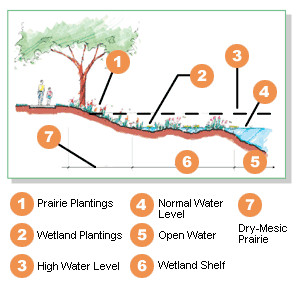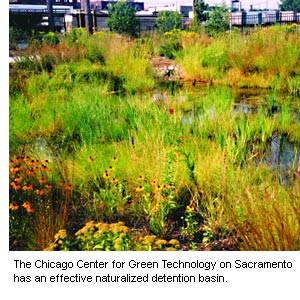Naturalized Detention Basins
 |
Conventional detention is designed to prevent flooding by temporarily storing stormwater runoff and releasing it gradually to the downstream drainage system. Naturalized detention is intended to serve multiple functions, in addition to flood prevention, including pollutant removal and creation of wildlife habitat (where appropriate).Natural detention basin designs emulate natural lake or wetland systems by utilizing native plants along the water's edge and on side slopes. The design generally incorporates flat slopes at the edge of the water or wetland, shallow zones of emergent vegetation at the edge of wet basins, and a combination of vegetated and open water areas in wetland basins. Effective detention designs will dramatically reduce runoff rates and prevent most increases in flooding associated with new development. However, unless underlying soils are highly permeable, detention will not significantly reduce flood volumes. The greatest benefit of naturalized designs is the reduction of runoff pollutants. Suspended sediments and attached pollutants, which are removed primarily by settling, can be reduced by 60 percent to 90 percent. Some dissolved pollutants, including nutrients and organic matter, can be reduced by 40 percent to 80 percent. |
Because wet basins are more effective at removing pollutants, in some instances they are a beneficial alternative to dry bottom basins. Naturalized basins also will not experience shoreline erosion, further improving water clarity.
Naturalized detention also can provide desirable habitat for birds and aquatic organisms and at the same time discourage nuisance populations of Canada geese that are commonly found around conventional basins. In addition, many property owners prefer the appearance of a well-designed natural basin over the more manicured look of a conventional basin (such as coarse gravel shorelines and/or concrete channels), thereby enhancing property value
|
Applicability
Maintenance Considerations
Cost Considerations |
|
Local Examples
A notable example of a naturalized detention basin in the City is at the CET1 power plant located at 117th & Torrence Avenue.

